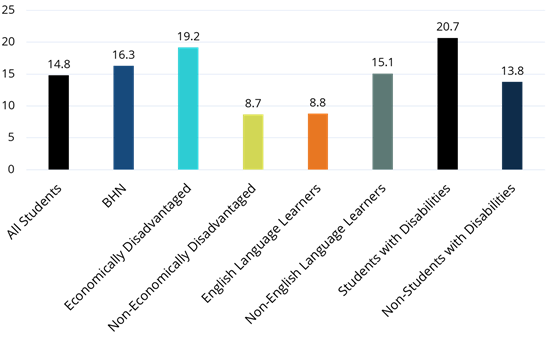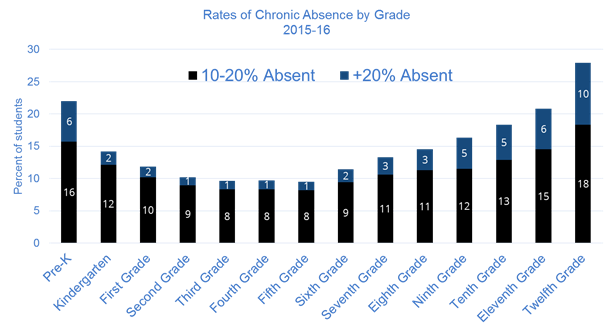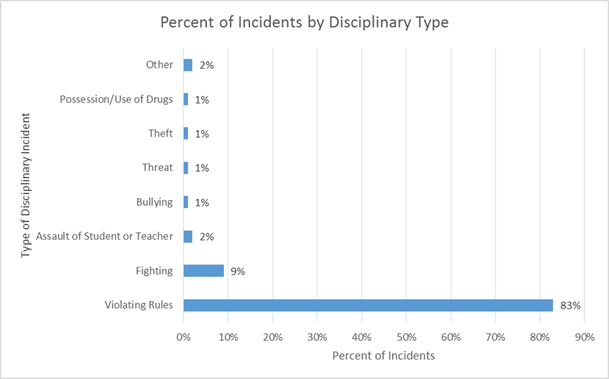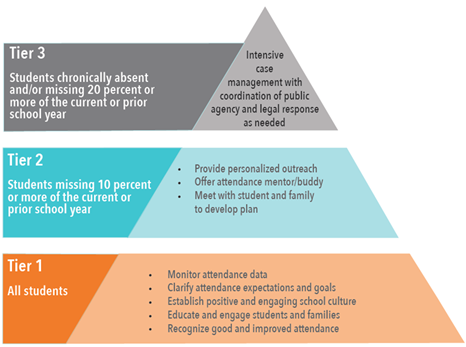Chronic Absenteeism
Beginning in the 2017-18 school year, chronic absenteeism will be a part of district and school accountability. The measure will be called the Chronically Out-of-School Indicator. This indicator will be based on what research calls chronic absenteeism, which is defined as a student missing 10 percent or more of the days the student is enrolled-for any reason, including excused absences and out-of-school suspensions. Excessive absences from school represent lost instructional time for a student. The department of education encourages districts and schools to carefully review attendance data throughout the school year to ensure supports are in place to maximize learning time for all students.
In order to be successful in addressing chronic absenteeism, it is important that we view attendance as more than a legal or compliance issue and try to understand what factors may be contributing to a student’s absences. Furthermore, we can best serve students by viewing attendance as an opportunity to learn and chronic absences as an indication of barriers or conditions that are limiting that opportunity.
Capturing the importance of the chronically out of school indicator begins with an understanding of four key attendance terms.
- Average Daily Attendance: The percent of enrolled students who attend school each day. While the average daily attendance rate has been used for reporting purposes for many years, the use of a single average measure tends to mask significant attendance problems.
- Truancy: A legal term that refers only to unexcused absences. A Tennessee student is considered truant at five unexcused absences and may be subject to legal intervention.
- Chronic Absenteeism: Missing school for any reason (excused, unexcused, suspended/expelled). Commonly defined as missing 10 percent or more of instructional days, the threshold at which research indicates most students are at risk of negative academic and social consequences.
- Exclusionary Discipline: The removal of a student from his/her regular academic program for disciplinary purposes.
- Multiple research studies link poor attendance with reduced academic outcomes and many subgroups are disproportionately represented in chronic absenteeism data. Highlights of national research can be found here. From a Tennessee perspective, we know that Tennessee students who are chronically absent in kindergarten are 15 percentage points less likely to reach proficiency in either third grade math or ELA. We also know that Tennessee students who are chronically absent in ninth grade are 30 percentage points less likely to earn an on-time diploma (62% vs. 92%).
- Only looking at average daily attendance rates tends to mask attendance problems, both within subgroups and at schools across districts. The table below is actual data from a small, rural East Tennessee school district.
| District X Elementary Schools | Average Daily Attendance Rate | % of Students Chronically Absent | % of ED Students |
|---|---|---|---|
| School A | 93.8 | 17.9 | 87.6 |
| School B | 94.7 | 12.1 | 58.5 |
| School C | 95.0 | 9.9 | 77.5 |
| School D | 96.3 | 6.7 | 42.8 |
The following chart highlights chronic absence rates for various subgroups of Tennessee students during the 2014-15 school year.

- The harmful effects of poor attendance are cumulative and may be masked if absences do not occur consecutively. Students tend to repeat poor attendance patterns, further compounding its harmful effects.
- Districts and schools have access to rich attendance data that can be monitored throughout the school year, serving as an invaluable early indicator of changes in the student’s relationship with school.
- Chronically missing school is reflective of conditions at school and/or barriers at home or in the community that can be successfully addressed.
Fortunately, there are numerous rich data sources that can be helpful in identifying the unique nature of chronic attendance problems at a school or district. Successfully addressing chronic absenteeism starts with examining available data and identifying root causes.
Student Management System – Attendance And Discipline Data
A logical first step is to dig into attendance and discipline data contained within the district’s student management system. How do chronic absenteeism rates differ across schools, grades and subgroups within the district? How many of the absences can be attributed to excused, unexcused or disciplinary reasons. Are there periods within the school calendar that are particularly problematic? At the building level, this review can be similar with an additional opportunity to identify crossovers with students who may be already identified via RTI2 or other ongoing support initiatives.

Similarly, discipline data can be helpful in identifying the nature of students receiving exclusionary discipline, the behaviors resulting in discipline and the possibility of introducing disciplinary alternatives such as restorative practices.
Attendance Works makes available at no cost data tools that work with your student management system to generate helpful reports.

Coordinated School Health/School Nurses – Student Health Conditions
Student health, including seasonal as well as chronic conditions such as asthma or diabetes, can be a significant factor in student absences. Coordinated school health directors and school nurses are an excellent source of data on district and building-level chronic health conditions of students. These same persons can be an excellent source of suggestions and practices in reducing health-related absences.
Student/Family Support Services – Barriers To Attendance
Student support personnel such as parent engagement specialists or family resource center directors are an excellent source of information on barriers that students and families may be encountering in getting to school.
Students And Parents – Barriers, School Climate/Culture, Instructional Opportunities
A frequently overlooked source of invaluable qualitative data is students and caregivers themselves. Student and parent survey resources are available at no cost from the Safe and Supportive Schools program. These surveys provide an opportunity to better understand student and parent perceptions of their school experience. An alternative would be to conduct interviews or focus groups with students and/or parents and caregivers.
Transportation And Other Nontraditional Sources – Barriers, Climate/Culture
Invaluable information can come from unexpected sources—leverage and dig into your local resources. For example, one rural Tennessee attendance specialist relies on hearing reports from school bus drivers in order to identify students and families in need of assistance. Similarly, local pediatricians can be a great source of information and powerful partner in addressing student health conditions.
Effectively addressing chronic absenteeism requires multiple levels of response.

While the identification of tier thresholds can and should vary from school to school and district to district, a good starting point is to consider students with chronic absence rates between 10% and 19% as being in Tier 2 and students with chronic absence rates at 20% or above as being Tier 3.
Attendance Works has produced an outstanding guide for helping schools develop a multi-tiered response to chronic absenteeism which includes examples of strategies in each of the three tiers along with worksheets for helping a school team develop a response that is specific to their unique situation. The resource guide can be found here.
A few important points to consider include:
- A solid Tier 1 foundation for all students is essential and will ultimately reduce students moving into Tiers 2 and 3.
- Effective, engaging instruction for all students is THE most important factor relative to improving attendance and ultimately supporting student success.
- Recognizing good and improved attendance can and should be more encompassing than perfect attendance awards
- Monitoring attendance and discipline trends on an ongoing basis is key to intervening on a timely basis. Consider poor or worsening attendance patterns to be an early warning indicator.
- Best practice indicates that Tier 2 students generally require some level of individualized attention. Depending upon the number of students and staff resources, external assistance may be in order.
- Parents and caregivers respond best to personalized, positive messaging delivered by someone with whom they have an existing relationship. Automated attendance calls lose their effectiveness as absences increase.
- Attendance messaging is most effective when delivered early in the school year and before poor attendance patterns develop.
A wealth of helpful resources are available to help school leaders address chronic absenteeism. A few of the more extensive sources include:
- Attendance Works is a national leader in the field of chronic absenteeism. All of their resources, including an extensive set of parent communication and training materials, are available at no cost and easily accessible from their well-developed website.
- Every Student, Every Day is a community toolkit produced by the U.S. Departments of Education, Justice, Health and Human Services, and Housing and Urban Development.
- Chronic Absenteeism in Tennessee’s Early Grades is a research brief prepared by the research office of the Tennessee Department of Education.
- The Student Supports Overview webpage provides a gateway to resources available through the Tennessee Department of Education to help schools address the varied needs of students and families. Focus areas include school climate/culture, health and nutrition, behavior and discipline, as well as student and family support.